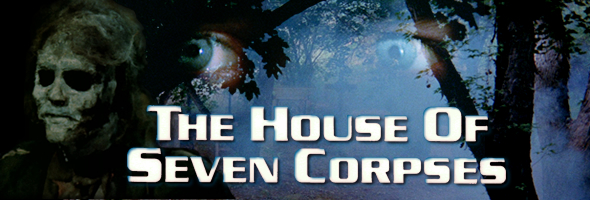

Color, 1974, 91m.
Directed by Paul Harrison
Starring John Ireland, Faith Domergue, John Carradine, Carole Wells, Charles Macaulay, Jerry Strickler, Ronald Victor Garcia
Severin (Blu-ray & DVD) (US R0 HD/NTSC) / WS (1.85:1) (16:9), Image, Geneon (US R0 NTSC)
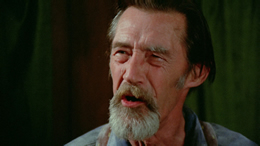
A charmingly retro oddity released just as horror fans were being assaulted
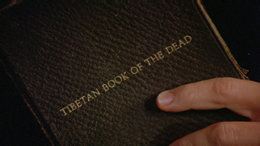 by gory R-rated fare, The House of Seven Corpses is precisely the kind of film you stumble across late at night because of its wild cast and can't quite piece together when you try to remember it the next morning. Colorful, strange, and eerie at times, it's had a surprisingly durable shelf life over the years thanks to a long string of video releases and perpetual TV airings, none of them remotely as respectful as the Blu-ray and DVD edition unrolled from Severin Films.
by gory R-rated fare, The House of Seven Corpses is precisely the kind of film you stumble across late at night because of its wild cast and can't quite piece together when you try to remember it the next morning. Colorful, strange, and eerie at times, it's had a surprisingly durable shelf life over the years thanks to a long string of video releases and perpetual TV airings, none of them remotely as respectful as the Blu-ray and DVD edition unrolled from Severin Films. Our terror tale begins with that old standby, a gruesome vignette that turns out to be a film production in progress. Here we have a staged satanic ritual conducted by over-the-hill actress Gayle Dorian (Domergue), with a cast and crew all holed up at an infamous, spooky mansion owned by the Beal family -- all of whom perished under sinister condition in the best Hill House tradition. The crusty caretaker Edgar (Carradine, of course) warns them that it's not wise to trespass upon such deadly ground, but of course the director, Eric (Ireland), has no issues at all in using the real site of bloodshed and tragedy. Faster than you can say "Necronomicon Ex Mortis," they stumble upon a "Tibetan Book of the Dead" (no resemblance at all to the real thing) and work it in as a pivotal prop, which is never a good idea. Soon it becomes apparent that the seven deaths in the house's past might be recreated before the cameras roll for the last scene...
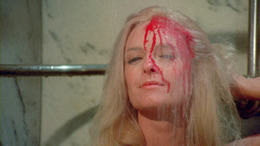
Shot in Salt Lake City, Utah, this modest little chiller was the final film of actress Faith Domergue, a sci-fi favorite from her busy
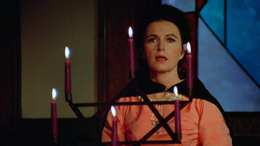 year of 1955 when she appeared in This Island Earth, It Came from Beneath the Sea, and Cult of the Cobra. She and Ireland had teamed up before in minor roles in Lucio Fulci's jazzy giallo Perversion Story, but they're better served here with their snippy dialogue even if they ultimately wind up taking a back seat to the ostensible heroine of the film, ingénue Anne, who's played by Carole Wells. Weirdly, Domergue had also worked with John Carradine before on the tonally similar but inferior Carl Monson cheapie Legacy of Blood, while Carradine and Ireland would shortly reunite for Satan's Cheerleaders. The horror acting community certainly is a strange, bloody little pond. Perhaps the weirdest casting choice is actually Wells, a former child actor who had just been widowed one year before with the death of her first husband, Los Angeles oil dynasty member Edward Laurence Doheny IV -- and her mother-in-law, Lucy Doheny (whose own past was also stained by murder), even pops up in this film as the late Suzanne Beal. As if that weren't all peculiar enough, her dead, bearded husband in the film is played by Ron Garcia (also art director on this film), who penned the Harry Novak exploitation favorites The Toy Box and Machismo, shot Schoolgirls in Chains, and went on to lens Twin Peaks: Fire Walk with Me and a slew of recent TV shows. And if this film's cinematographer sounds familiar, that's because it's Don Jones, director of The Love Butcher and The Forest.
year of 1955 when she appeared in This Island Earth, It Came from Beneath the Sea, and Cult of the Cobra. She and Ireland had teamed up before in minor roles in Lucio Fulci's jazzy giallo Perversion Story, but they're better served here with their snippy dialogue even if they ultimately wind up taking a back seat to the ostensible heroine of the film, ingénue Anne, who's played by Carole Wells. Weirdly, Domergue had also worked with John Carradine before on the tonally similar but inferior Carl Monson cheapie Legacy of Blood, while Carradine and Ireland would shortly reunite for Satan's Cheerleaders. The horror acting community certainly is a strange, bloody little pond. Perhaps the weirdest casting choice is actually Wells, a former child actor who had just been widowed one year before with the death of her first husband, Los Angeles oil dynasty member Edward Laurence Doheny IV -- and her mother-in-law, Lucy Doheny (whose own past was also stained by murder), even pops up in this film as the late Suzanne Beal. As if that weren't all peculiar enough, her dead, bearded husband in the film is played by Ron Garcia (also art director on this film), who penned the Harry Novak exploitation favorites The Toy Box and Machismo, shot Schoolgirls in Chains, and went on to lens Twin Peaks: Fire Walk with Me and a slew of recent TV shows. And if this film's cinematographer sounds familiar, that's because it's Don Jones, director of The Love Butcher and The Forest. TV writer Paul Harrison (H.R. Pufnstuf) never made another feature besides this one; he shows a fairly
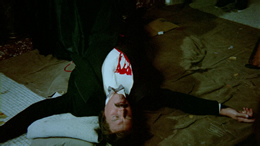 proficient hand with gothic atmosphere, even though he can't quite maintain a solid hold on the plot.
proficient hand with gothic atmosphere, even though he can't quite maintain a solid hold on the plot. 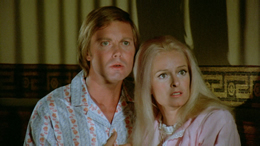 Apparently more than a few people involved weren't quite sure what the story was all about according to the audio commentary on the Severin release, featuring associate producer Gary Kent and moderator Lars Nilsen of the Alamo Drafthouse. Apparently Kent was more of a regular producer on the film (for reasons he explains), and he covers a huge amount of background info on the film including the real shooting location at the Utah State Historical Society ("Boy, does it ever have character"), the "great schmoozer" Harrison, the theft of a freight train, John Ireland's legendary bad boy behavior and love of ganja (and Carradine taking a toke in the men's room on a related note), the conning "Mormon dowagers" into providing props, the problems of shooting in a dry state, a dentist investor who enthusiastically provided body goo for Wells' "nude" scene, and much more. Fantastic, hilariously candid stuff, and practically worth the price tag by itself. Also included are the theatrical trailer and a 1983 interview with John Carradine, apparently unreleased until now, which runs 28 minutes and was evidently sourced from a VHS copy. It's a nice little career retrospective as he talks about his life, theater work, colleagues like Bela Lugosi, and a variety of his films like The Howling, The Secret of NIMH, and House of the Long Shadows. As for the main feature, this is definitely a case of giving it some historical context as past video transfers have been pretty dismal. VHS copies were mostly unwatchable, and the first DVD from Image Entertainment in 2000 (no frills apart from the peculiar addition of a Spanish-dubbed audio track) and the reissue from Geneon weren't much better. The Severin transfer looks quite impressive on the Blu-ray disc (which comes with a DVD option if you'd prefer it), with far better color and a nicely textured 35mm ambience. It's still a cheap, ragged horror film, of course, but this is a drastic improvement across the board. The DTS-HD mono track is much clearer than before as well, and now divorced from the muddy presentations that have dragged this film's reputation through the mud for decades, horror fans will find quite a fun, spooky little treat in store for them here.
Apparently more than a few people involved weren't quite sure what the story was all about according to the audio commentary on the Severin release, featuring associate producer Gary Kent and moderator Lars Nilsen of the Alamo Drafthouse. Apparently Kent was more of a regular producer on the film (for reasons he explains), and he covers a huge amount of background info on the film including the real shooting location at the Utah State Historical Society ("Boy, does it ever have character"), the "great schmoozer" Harrison, the theft of a freight train, John Ireland's legendary bad boy behavior and love of ganja (and Carradine taking a toke in the men's room on a related note), the conning "Mormon dowagers" into providing props, the problems of shooting in a dry state, a dentist investor who enthusiastically provided body goo for Wells' "nude" scene, and much more. Fantastic, hilariously candid stuff, and practically worth the price tag by itself. Also included are the theatrical trailer and a 1983 interview with John Carradine, apparently unreleased until now, which runs 28 minutes and was evidently sourced from a VHS copy. It's a nice little career retrospective as he talks about his life, theater work, colleagues like Bela Lugosi, and a variety of his films like The Howling, The Secret of NIMH, and House of the Long Shadows. As for the main feature, this is definitely a case of giving it some historical context as past video transfers have been pretty dismal. VHS copies were mostly unwatchable, and the first DVD from Image Entertainment in 2000 (no frills apart from the peculiar addition of a Spanish-dubbed audio track) and the reissue from Geneon weren't much better. The Severin transfer looks quite impressive on the Blu-ray disc (which comes with a DVD option if you'd prefer it), with far better color and a nicely textured 35mm ambience. It's still a cheap, ragged horror film, of course, but this is a drastic improvement across the board. The DTS-HD mono track is much clearer than before as well, and now divorced from the muddy presentations that have dragged this film's reputation through the mud for decades, horror fans will find quite a fun, spooky little treat in store for them here. Reviewed on August 10, 2013.
![]()